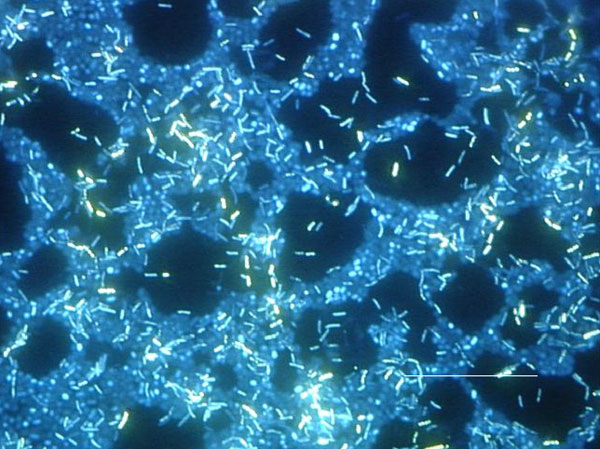
Patrick Yang ‘20
Pseudomonas aeruginosa is a multidrug resistant bacterium responsible for serious medical illnesses, such as pneumonia, sepsis, and cystic fibrosis. The bacterium produces a metabolite called pyocyanin, which largely contributes towards the pathogen’s toxicity. A recent discovery found that pyocyanin also aids in the aggregation of bacteria to form biofilm. Biofilm, a community of microorganisms that is resistant to conventional antibiotics, makes infection treatment difficult. However, the recent discovery of pyocyanin’s role in biofilm development offers a new mechanism for researchers to combat dangerous medical illnesses.
Dr. Dianne K. Newman of the California Institute of Technology and her team analyzed an enzyme that was isolated from Mycobacterium fortuitum, a bacterium found in soil. The enzyme, pyocyanin demethylase, was applied to twelve independent cultures of P. aeruginosa to test if the enzyme selectively degraded pyocynanin. More than 50% of biofilm is composed of extracellular DNA, so DNase, an enzyme that degrades DNA, was also added to cultures as a control. Surface coverage of pyocyanin demethylase-treated cultures was found to be 43.5%, compared with 82.7% in the absence of the enzyme. This significant difference in culture size implies pyocyanin demethylase’s ability to regulate biofilm growth and confirms pyocyanin’s role in biofilm formation. DNase-treated cultures showed similar results to pyocyanin demethylase-treated cultures.
Dr. Newman’s team proposed demethylation as the mechanism for pyocyanin demethylase because of the formation of formaldehyde and 1-hydroxyphenazine. Since pyocyanin demethylase functioned to similar extents as DNase in regulating biofilm growth, it is hypothesized that pyocyanin demethylase halts the release of biofilm DNA, which is a major component of the extracellular matrix of biofilm. This suggests that pyocyanin, the target of pyocyanin demethylase, aids in biofilm formation by causing DNA release, which leads to its intrinsic antibiotic resistance. Pyocyanin demethylase prevents this DNA release by degrading pyocyanin, which impedes biofilm growth. Further understanding of biofilm formation will yield more promising research towards treating antibiotic-resistant infections.
References:
- Costa, et al., Pyocyanin degradation by a tautomerizing demethylase inhibits pseudomonas aeruginosa biofilms. Science (2016). doi: 10.1126/science.aag3180.
Image retrieved from: https://commons.wikimedia.org/wiki/File:Polymicrobic_biofilm_epifluorescence.jpg.

